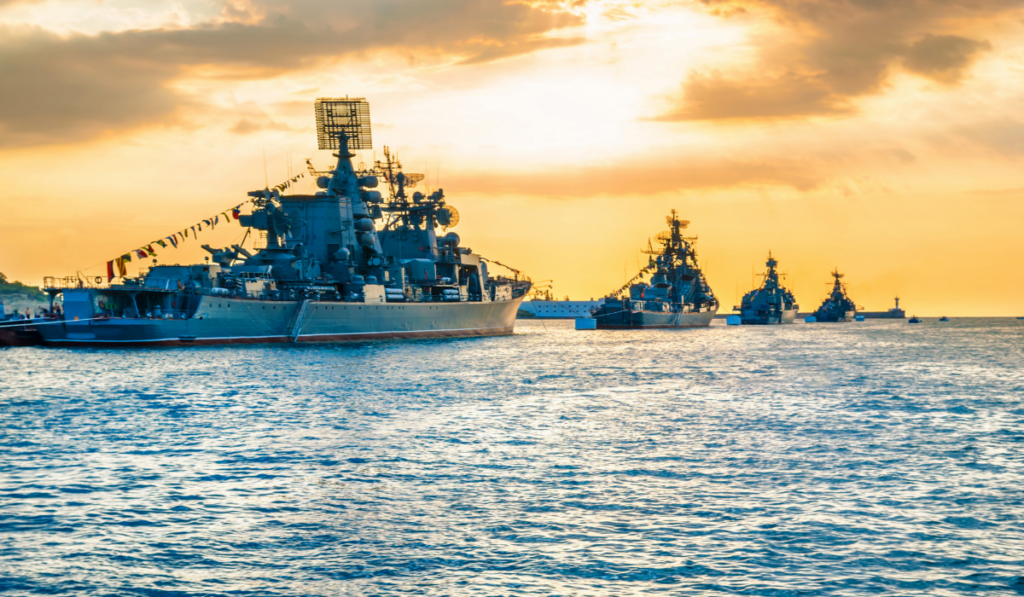Asbestos Exposure on Destroyers
Many Navy Vessels, including destroyers, built before the 1980s are known to contain asbestos.

Home » Nationwide Mesothelioma Lawyers » Veterans and Mesothelioma » Navy » Asbestos on Destroyers
- Content last modified:
Navigate this page
- USS Barton (DD-599)
- USS Bausell (DD 845)
- USS Beale (DD-471)
- USS Borie (DD 704)
- USS Buck (DD 761)
- USS Chandler (DDG 996) (ex-DD 996)
- USS Chauncey (DD 667)
- USS Chevalier (DD 805) (ex-DDR 805)
- USS Coontz (DDG 40) (ex-DLG 9)
- USS Cowell (DD 547)
- USS Dahlgren (DDG 43) (ex-DLG 12)
- USS Decatur (DDG 31) (ex-EDDG 31, DD 936)
- USS Forrest Sherman (DD 931)
- USS George K Mackenzie (DD 836)
- USS Glennon (DD 840)
- USS Goodrich (DD 831) (ex-DDR 831)
- USS Gurke (DD 783)
- USS Hanson (DD 832) (ex-DDR 832)
- USS Holder (DD 819) (ex-DDE 819)
- USS Holder (DD 819) (ex-DDE 819)
- USS Hollister (DD 788)
- USS Hugh Purvis (DD 709)
- USS John W Thomason (DD 760)
- USS King (DDG 41) (ex- DLG 10)
- USS Laffey (DD 724)
- USS Maddox (DD 731)
- USS Marshall (DD 676)
- USS McKean(DD 784) (ex-DDR 784)
- USS Mullany (DD 528)
- USS Ozbourn (DD 846)
- USS Richard E Kraus (DD 849) (ex- AG 151)
- USS Robert A Owens (DD 827) (ex- DDK 827, DDE 827)
- USS Robison (DDG 12)
- USS Rooks (DD 804)
- USS Rowan (DD 782)
- USS Stephen Potter (DD 538)
- USS Trathen (DD 530)
- USS Turner Joy (DD 951)
- USS Vesole (DD 878) (ex-DDR 878)
- USS Wallace L Lind (DD 703)
- USS Waller (DD 466)
- We Can Help
Destroyers serve as quick and easily maneuvered warships which generally escort larger ships in the fleet. They also serve as protection for the larger ships from torpedo and submarine attacks. Destroyers were usually outfitted with anti-aircraft guns and anti-submarine weapons, however, despite being heavily armed and prepared for any emergency, destroyers were the most frequently sunk ship during World War II. The men on these ships faced a number of dangers on a day to day basis. A danger they faced, unknowingly, was Asbestos. Asbestos was found in a number of areas on these ships, in particular the insulation that lined piping.
Anyone who served on a destroyer should speak with their doctor regarding asbestos related diseases, such as Mesothelioma and Lung Cancer, and the treatment options available.
USS Barton (DD-599)
- Classification: Destroyer
- Status: Sunk by Japanese Destroyer Amatsukaze off Guadalcanal 13
- Fleet:
- Launch Date: 1/13/1942
- Commission Date: 5/29/1942
- Decommission Date: NA
USS Bausell (DD 845)
The USS Bausell, a destroyer decommissioned in 1978, operated out of San Diego. It was launched in 1945 and built with many products containing asbestos.
- Classification: Destroyer
- Status: Disposed of in Support of Fleet Training Exercise
- Fleet: 7th Fleet
- Launch Date: 11/19/1945
- Commission Date: 2/7/1946
- Decommission Date: 5/30/1978
The USS Bausell operated out of San Diego and participated in fleet exercises and training. She also completed two tours of the Far East, specifically Korea. She received three battle stars for her Korean Service.
USS Beale (DD-471)
- Classification: Destroyer
- Status: Sunk as Target 6/24/1969
- Fleet: Pacific
- Launch Date: 8/24/1942
- Commission Date: 12/23/1942
- Decommission Date: 9/30/1968
USS Beale was a Fletcher Class Destroyer received six battle stars for her service during the war and became one of the most celebrated ships of World War II. During 1944 and 1945, she was one of the most active ships in the fleet participating in bombardments of New Guinea, Hollandia, Wakde Tome, Biak, and the invasion of Okinawa.
USS Borie (DD 704)
The USS Borie was built during WWII using materials and parts contaminated with asbestos. Asbestos was found in a number of areas, in particular the insulation that lined piping.
- Classification: Destroyer
- Status: Disposed of through Navy sale
- Fleet: Pacific/Atlantic
- Launch Date: 7/4/1944
- Commission Date: 9/21/1944
- Decommission Date: 7/1/1972
USS Borie joined the Pacific fleet in World War II and took part in the Iwo Jima bombardment and invasion. A kamikaze crashed into her superstructure between the mast and the gun director which caused extensive damage and ended up killing 48 men and wounding 66. As part of the Atlantic fleet after the war, she made several cruises to Europe and the Mediterranean. She did make one cruise to Korea while part of the Atlantic fleet where she took part in the Hungnam Evacuation. She has a few notable missions, such as the recovery of the Project Mercury Nose Cone and Sam, the space monkey. She also rescued Cubans seeking asylum in the United States before joining the blockade during the Cuban Missile Crisis. During Vietnam, she served in the Tonkin Gulf on plane guard and radar picket duty. The USS Borie received three battle stars for her World War II service and four battle stars for her participation in the Korean War.
USS Buck (DD 761)
- Classification: Destroyer
- Status: Disposed of through the Security Assistance Program (SAP), transferred, cash sale, ex-US fleet hull foreign military sale case number assigned
- Fleet: Pacific
- Launch Date: 3/11/1945
- Commission Date: 6/28/1946
- Decommission Date: 7/15/1973
USS Buck received six battle stars for her service during the Korean War.
USS Chandler (DDG 996) (ex-DD 996)
- Classification: Destroyer
- Status: Disposed of through the Security Assistance Program (SAP), transferred, cash sale, ex-US fleet hull foreign military sale case number assigned.
- Fleet: Pacific
- Launch Date: 5/24/1980
- Commission Date: 3/13/1982
- Decommission Date: 9/23/1999
USS Chauncey (DD 667)
- Classification: Destroyer
- Status: Disposed of by Navy Sale
- Fleet: Pacific/Atlantic
- Launch Date: 3/28/1943
- Commission Date: 5/31/1943
- Decommission Date: 5/14/1954
The USS Chauncey participated in several missions during World War II in the Pacific taking down numerous enemy planes. At one point, she even saved three downed aviators from the water. For her service during the Second World War, she received seven battle stars. Her time in combat was not done; however, she was also deployed during the Korean War, earning two battle stars for service.
USS Chevalier (DD 805) (ex-DDR 805)
- Classification: Destroyer
- Status: Disposed of through the Security Assistance Program (SAP), transferred, cash sale, ex-US fleet hull foreign military sale case number assigned.
- Fleet:
- Launch Date: 10/29/1944
- Commission Date: 1/9/1945
- Decommission Date: 6/2/1975
The USS Chevalier received one battle star for her World War II service, and nine for her Korean War Service.
USS Coontz (DDG 40) (ex-DLG 9)
- Classification: Destroyer
- Status: Disposed of by scrapping, dismantling
- Fleet:
- Launch Date: 12/6/1958
- Commission Date: 7/15/1960
- Decommission Date: 10/4/1989
The USS Coontz spent most of her time in the Western Pacific during the Vietnam War, however she did spend some time in Alaska, the Mediterranean, North Atlantic, Grenada, and the Persian Gulf.
USS Cowell (DD 547)
- Classification: Destroyer
- Status: Disposed of through the Security Assistance Program (SAP), transferred, cash sale, ex-US fleet hull foreign military sale case number assigned.
- Fleet: Pacific/Atlantic
- Launch Date: 3/18/1943
- Commission Date: 8/23/1943
- Decommission Date: 8/17/1971
USS Cowell received the Presidential Unit Citation, eleven battle stars for her World War II service, and two for Korean War service.
USS Dahlgren (DDG 43) (ex-DLG 12)
- Classification: Destroyer
- Status: Disposed of by scrapping dismantling
- Fleet:
- Launch Date: 3/16/1960
- Commission Date: 4/8/1961
- Decommission Date: 7/31/1992
The USS Dahlgren spent most of their time in the Mediterranean – Indian Ocean, with brief trips to the Arctic Circle, Persian Gulf, Arabian Gulf.
USS Decatur (DDG 31) (ex-EDDG 31, DD 936)
- Classification: Destroyer
- Status: Disposed of in support of fleet training exercise
- Fleet:
- Launch Date: 10/1/1955
- Commission Date: 10/7/1956
- Decommission Date: 6/30/1983
USS Forrest Sherman (DD 931)
- Classification: Destroyer
- Status: Stricken, to be disposed of by dismantling
- Fleet: 7th
- Launch Date: 2/5/1955
- Commission Date: 11/9/1955
- Decommission Date: 11/5/1982
USS George K Mackenzie (DD 836)
- Classification: Destroyer
- Status: Disposed of in Support of Fleet Training Exercise
- Fleet:
- Launch Date: 5/13/1945
- Commission Date: 7/13/1945
- Decommission Date: 9/30/1976
During the Korean War, the USS George K Mackenzie screened attack carriers and provided close support for advancing allied armies. She also provided antisubmarine screening and fired several important bombardment missions. She completed a total of nine tours of duty in the Far East and was awarded six battle stars for her service. She was screening the USS Forrestal (CVA-59) when a fire broke out on the carrier’s flight deck. The USS George K Mackenzie helped put out the flames and escorted the carrier to Subic Bay for repairs.
USS Glennon (DD 840)
- Classification: Destroyer
- Status: Disposed of in Support of Fleet Training Exercise
- Fleet: 6th/Atlantic
- Launch Date: 7/14/1945
- Commission Date: 10/4/1945
- Decommission Date: 10/1/1976
The USS Glennon spent most of her time on training missions and exercises. She was chosen to man the Atlantic recovery station for the historic three orbit flight of Maj. John Glenn. In 1964 she was chosen to carry guests to the America’s Cup Races.
USS Goodrich (DD 831) (ex-DDR 831)
- Classification: Destroyer
- Status: Disposed of by Navy Sale
- Fleet:
- Launch Date: 2/25/1945
- Commission Date: 4/24/1945
- Decommission Date: 11/30/1969
USS Gurke (DD 783)
- Classification: Destroyer
- Status: Disposed of through the Security Assistance Program (SAP), transferred, cash sale, ex-US fleet hull foreign military sale case number assigned.
- Fleet: 7th
- Launch Date: 2/15/1945
- Commission Date: 5/12/1945
- Decommission Date: 1/30/1976
At the outset of the Korean War, the USS Gurke shared with five other destroyers the award of the Navy Unit Commendation to Task Element 90.62 for extraordinary heroism in support of the landing at Inchon. After the initial landing at Inchon, General Douglas MacArthur is quoted as saying “The Navy and Marines have never shone more brightly than this morning.” Throughout the war, she screened attack carriers, patrolled various waterways, and bombard enemy coastal supply routes. The USS Gurke received seven battle stars for her service in the Korean War.
USS Hanson (DD 832) (ex-DDR 832)
- Classification: Destroyer
- Status: Disposed of in Support of through the Security Assistance Program (SAP), transferred, cash sale, ex-US fleet hull foreign military sale case number assigned.
- Fleet: 6th/Pacific/7th
- Launch Date: 3/11/1945
- Commission Date: 5/11/4945
- Decommission Date: 3/31/1973
The USS Hanson made several combat cruises to Korea during the war, and even took part in shore bombardment and search and rescue operations. In 1972, during the Vietnam War, she set sail for her last tour of duty as a US Naval Vessel, and this would also be her most fierce wartime effort. Arriving in North Vietnam with guns blazing, she took part in combat action “Operation Freedom Train” and engaged in a series of raids on the Haiphong complex. These raids lasted for a month, and the USS Hanson did sustain battle damage from direct and shrapnel hits. In September of 1972, she received word that US troops were in need of immediate assistance 40 miles away. She quickly steamed through dangerous waters consisting of shallow reefs and anti-ship mines to come to their aid, and effectively directed artillery rounds onto enemy troops saving all 120 US soldiers. The crew on this cruise was awarded the Meritorious Unit Commendation, Combat Action Ribbon, National Defense Service Medal, Vietnam Service Medal, and the Vietnam Campaign Medal for their heroism in saving fellow US troops. The USS Hanson received eight battle stars for her service during the Korean War and seven battle stars for her service in the Vietnam War. She was later transferred to the Republic of China and after 31 years of service in China, she was sunk in the South China Sea as an artificial reef.
USS Holder (DD 819) (ex-DDE 819)
- Classification: Destroyer
- Status: Disposed of through Security Assistance Program (SAP), transferred, cash sale, ex-US fleet hull foreign military sale case number assigned.
- Fleet: 6th/Pacific
- Launch Date: 8/25/1945
- Commission Date: 5/18/1946
- Decommission Date: 10/1/1976
The USS Holder spent most of her time conducting training exercises in the Atlantic and Mediterranean. She participated in the Cuban Missile Crisis blockade in 1962. She also acted as plane guard for the USS Intrepid in the Pacific.
USS Holder (DD 819) (ex-DDE 819)
- Classification: Destroyer
- Status: Disposed of through Security Assistance Program (SAP), transferred, cash sale, ex-US fleet hull foreign military sale case number assigned.
- Fleet: 6th/Pacific
- Launch Date: 8/25/1945
- Commission Date: 5/18/1946
- Decommission Date: 10/1/1976
The USS Holder spent most of her time conducting training exercises in the Atlantic and Mediterranean. She participated in the Cuban Missile Crisis blockade in 1962. She also acted as plane guard for the USS Intrepid in the Pacific.
USS Hollister (DD 788)
- Classification: Destroyer
- Status: Disposed of through the Security Assistance Program (SAP), transferred, cash sale, ex-US fleet hull foreign military sale case number assigned.
- Fleet:
- Launch Date: 10/9/1945
- Commission Date: 3/26/1946
- Decommission Date: 9/1979
USS Hugh Purvis (DD 709)
- Classification: Destroyer
- Status: Disposed of through the Security Assistance Program (SAP), transferred, cash sale, ex-US fleet hull foreign military sale case number assigned.
- Fleet: 6th
- Launch Date: 12/17/1944
- Commission Date: 3/1/1945
- Decommission Date: 7/15/1972
During the Korean conflict, the USS Hugh Purvis deployed with the 6th fleet on several occasions and completed several training missions and exercises. After that, she continued training missions and various exercises while protecting peace and security of the free world.
USS John W Thomason (DD 760)
- Classification: Destroyer
- Status: Disposed of through Security Assistance Program (SAP), transferred, cash sale, ex-US Fleet hull foreign military sale case number assigned.
- Fleet: 7th
- Launch Date: 9/30/1944
- Commission Date: 10/11/1945
- Decommission Date: 12/8/1970
USS John W Thomason spent most of her early career on training missions and exercises. During the Korean War, she fired at railway targets, performed patrol duty, and screened larger units. The USS John W Thomason received seven battle stars for her service in Korea.
USS King (DDG 41) (ex- DLG 10)
- Classification: Destroyer
- Status: Disposed of by Navy Sale
- Fleet: 7th
- Launch Date: 12/6/1958
- Commission Date: 11/17/1960
- Decommission Date: 3/28/1991
USS Laffey (DD 724)
- Classification: Destroyer
- Status: Donated as a Museum and Memorial (Currently Located at the Patriots Point Naval & Maritime Museum, Mount Pleasant, SC).
- Fleet:
- Launch Date: 11/21/1943
- Commission Date: 2/8/1944
- Decommission Date: 3/29/1975
USS Laffey received the U.S. Presidential Unit Citation and five battle stars for World War II service, the Korean Presidential Unit Citation and two battle stars for Korean War service, and the Meritorious Unit Commendation. The USS Laffey was declared a National Historic Landmark in 1986.
USS Maddox (DD 731)
- Classification: Destroyer
- Status: Disposed of through Security Assistance Program (SAP), transferred, cash sale, ex-US fleet hull foreign military sale case number assigned.
- Fleet: 7th
- Launch Date: 3/19/1944
- Commission Date: 6/2/1944
- Decommission Date: 1969
The USS Maddox was involved in the Gulf of Tonkin Incident in 1964. During the Vietnam War her tour consisted primarily of providing gunfire support. She received four battle stars for her World War II service and six for her Korean War service.
USS Marshall (DD 676)
- Classification: Destroyer
- Status: Disposed of by Navy Sale
- Fleet: 7th/Pacific
- Launch Date: 8/29/1943
- Commission Date: 10/16/1943
- Decommission Date: 7/19/1969
The first big assignment for the USS Marshall was to rendezvous in the mid-Atlantic with the USS Iowa and escort President Roosevelt back from the Big Three Conference at Teheran. She received eight battle stars for her service in World War II and four battle stars for her Korean War service.
USS McKean(DD 784) (ex-DDR 784)
- Classification: Destroyer
- Status: Disposed of through the Security Assistance Program (SAP), transferred, cash sale, ex-US fleet hull foreign military sale case number assigned.
- Fleet: 7th
- Launch Date: 3/31/1945
- Commission Date: 6/9/1945
- Decommission Date: 10/1/1981
The USS McKean received one battle star for her service in the Korean War.
USS Mullany (DD 528)
- Classification: Destroyer
- Status: Disposed of through transfer
- Fleet: 7th/6th/Pacific
- Launch Date: 10/10/1942
- Commission Date: 4/23/1943
- Decommission Date: 10/6/1971
USS Mullany escorted troop transports for the invasion of Okinawa. On April 6, 1945, she sustained a kamikaze hit that slammed into the after deck house, followed shortly by the ship’s own depth charge exploding. An hour after this attack, a report was made that the bulkhead of one of the aft magazines was hot and an explosion was imminent. Skipper Commander Momm ordered the crew to abandon ship. The USS Gherardi stood by to take on survivors while her rescue team attempted to extinguish the flames. The hot magazine did not explode because the compartment was flooded, so the Commander took a skeleton crew back aboard and determined that they would be able to light one boiler and limp back to Pearl Harbor. Courage and determination of the crew saved the ship, but sadly 21 of her crew were killed, 9 missing, and 36 wounded. The USS Mullany received seven battle stars for her service during World War II. After the war, she made three peacekeeping missions to the Mediterranean with the 6th fleet. She also participated in the Vietnam War.
USS Ozbourn (DD 846)
- Classification: Destroyer
- Status: Disposed of by scrapping, dismantling
- Fleet: 7th
- Launch Date: 12/22/1945
- Commission Date: 3/5/1946
- Decommission Date: 1975
The USS Ozbourn took part in missions and assisted with air operations in Korea and Vietnam. Eight of her crewmen were recommended for decorations during actions in South Vietnam in which the USS Ozbourn provided tons of high explosives as covering fire. She received both the Meritorious Unit Commendation and the Battle Efficiency “E”.
USS Richard E Kraus (DD 849) (ex- AG 151)
- Classification: Destroyer
- Status: Disposed of through the Security Assistance Program (SAP), transferred, cash sale, ex-US fleet hull foreign military sale case number assigned.
- Fleet: 6th/7th
- Launch Date: 3/2/1946
- Commission Date: 5/23/1946
- Decommission Date: 7/1/1976
The USS Richard E Kraus earned the title of one of the “Shootingest Ships” in the fleet because in her first six years she was engaged in ordinance development. In October and November of 1962 she served with the U.S. quarantine forces preventing the introduction of offensive missiles into Cuba. The USS Richard E Kraus also played a key role in Vietnam, earning two battle stars for her service.
USS Robert A Owens (DD 827) (ex- DDK 827, DDE 827)
- Classification: Destroyer
- Status: Disposed of through the Security Assistance Program (SAP), transferred, Foreign Assistance Act (FAA) Section 516, Southern Region Amendment
- Fleet: 6th/2nd
- Launch Date: 7/15/1946
- Commission Date: 11/05/1949
- Decommission Date: 2/16/1982
The USS Robert A Owens conducted hunter-killer operations, anti-submarine patrols, and participated in NATO exercises in the beginning of her career. In February of 1962 she assisted in the recovery of Mercury 2 and Mercury 6 space capsules. Later that year, she became a member of the Cuban Quarantine Task Force. After that her duties took her to the Mediterranean, Red Sea, Indian Ocean, Atlantic, and Caribbean on various deployments.
USS Robison (DDG 12)
- Classification: Destroyer
- Status: Disposed of by Navy Sale
- Fleet: 7th
- Launch Date: 4/27/1960
- Commission Date: 12/9/1961
- Decommission Date: 10/1/1991
The USS Robison’s career was marked by routine deployments. In the 1960’s, her deployments usually placed her around Yankee Station in Tonkin Gulf as part of a screening task force around aircraft carriers. During the Vietnam War, she provided shore bombardment and destroyed light enemy supply craft. After Vietnam, she began regular deployments again in the Western Pacific. In total, she made 17 deployments and served for 29 years. The USS Robison earned seven battle stars for her service in Vietnam.
USS Rooks (DD 804)
- Classification: Destroyer
- Status: Disposed of through the Security Assistance Program (SAP), Foreign Military Sale or Lease
- Fleet: Pacific/Atlantic
- Launch Date: 6/6/1944
- Commission Date: 9/2/1944
- Decommission Date: 7/26/1962
USS Rooks arrived at Iwo Jima on D-Day in 1945, where she off loaded troops then assumed duties as a radar picket vessel. That afternoon, she moved to the southeastern corner of the island and silenced several enemy batteries. She then proceeded to Okinawa where she began an 87 day shore bombardment. USS Rooks is credited with shooting down six enemy aircraft during the battle of Okinawa. She earned three battle stars for her service in World War II and two battle stars for her service in the Korean War.
USS Rowan (DD 782)
- Classification: Destroyer
- Status: Run aground and wrecked while under tow
- Fleet: 7th/1st
- Launch Date: 12/29/1944
- Commission Date: 3/31/1945
- Decommission Date: 12/18/1975
The USS Rowan earned four battle stars for her service in the Korean War and 11 battle stars for her service in the Vietnam War.
USS Stephen Potter (DD 538)
- Classification: Destroyer
- Status: Disposed of by Navy Sale
- Fleet: Pacific/Atlantic
- Launch Date: 4/28/1943
- Commission Date: 10/21/1943
- Decommission Date: 4/28/1958
USS Stephen Potter screened and escorted aircraft carriers in the Pacific throughout 1944. During the Battle of the Philippine Sea, she rescued seven downed pilots from the water. She received 12 battle stars for her World War II service. After the war, she was decommissioned and placed in “moth balls.” However in 1951 she was re-commissioned and the USS Stephen Potter joined the United Nations Fleet off the east coast of Korea and operated there until the cessation of hostilities.
USS Trathen (DD 530)
- Classification: Destroyer
- Status: Used as Target Hulk, November 1973, scrapped
- Fleet: 7th/Atlantic
- Launch Date: 10/22/1942
- Commission Date: 5/28/1943
- Decommission Date: 5/11/1965
USS Trathen joined Task Force 11 immediately after training and began her first mission, reoccupation of Baker Island. She participated in gunnery exercises, acted as fire support, conducted antisubmarine patrols, screened ships, acted as plane guard, and conducted rescue missions during her time in the Pacific. She received eight battle stars for her service during World War II. USS Trathen participated in the Korean War as well, this time pounding railroad lines, trains, bunkers, and transformer stations as well as several antiaircraft and antisubmarine exercises. She earned one battle star for her service during the Korean War.
USS Turner Joy (DD 951)
- Classification: Destroyer
- Status: Donated as a Museum and Memorial
- (Currently Located at the Bremerton Historic Ships Association, 300 Washington Beach Ave, Bremerton, WA)
- Fleet: 7th/1st
- Launch Date: 5/5/1958
- Commission Date: 8/3/1959
- Decommission Date: 11/22/1982
USS Turner Joy was involved in the “Tonkin Incident” that brought the United States into the Vietnam War. She was very active in the war and made six deployments to the Western Pacific, she earned nine battle stars for her service.
USS Vesole (DD 878) (ex-DDR 878)
A Gearing-class destroyer, the USS Vesole was built by Consolidated Steel Corporation in 1944. Asbestos was found throughout the ship.
- Status: Disposed of in Support of Fleet Training Exercise
- Fleet: Pacific/2 nd/6 th
- Launch Date: 12/29/1944
- Commission Date: 4/23/1945
- Decommission Date: 12/01/1976
The USS Vesole patrolled the Pacific up and down the China coast and made stops at Japanese and Philippine ports after the war. In 1947 she cruised to the Atlantic conducting various exercises. She completed several training missions while in the Mediterranean before returning to the United States for duty along the east coast and in the Caribbean. During the 1950’s, she made routine deployments to the Mediterranean and the West Indies. The USS Vesole earned two battle stars for her service in the Vietnam Conflict.
USS Wallace L Lind (DD 703)
Built in 1944 by the Federal Shipbuilding and Dry Dock Company, the USS Wallace was built using asbestos as an insulator throughout the ship.
- Classification: Destroyer
- Status: Disposed of by scrapping, dismantling
- Fleet: 3rd/6th/2nd
- Launch Date: 6/14/1944
- Commission Date: 9/8/1944
- Decommission Date: 12/4/1973
USS Wallace L Lind was assigned to screen carriers in the Pacific during World War II along with other duties such as assisting with mail deliveries, helping transport personnel, acting as plane guard, recovering downed pilots, shore bombardments, antisubmarine operations, and conducting air patrols. She received four battle stars for her service during World War II. During the Korean War, in which she received four battle stars for her service, she was assigned similar duties before departing the area for the Mediterranean. After a tour in the Middle East, she set course for the Caribbean for training exercises. USS Wallace L Lind made generally routine trips back and forth from the Mediterranean to Florida only stopped by transfer to the Pacific for the Vietnam War. She earned three battle stars for her Vietnam War service.
USS Waller (DD 466)
The Federal Shipbuilding and Dry Dock Company built the USS Waller in 1942. Sunk in 1970, she had a stellar career. Asbestos was used as an insulator throughout the ship.
- Classification: Destroyer
- Status: Sunk as Target, June 17, 1970
- Fleet: 7th/3rd
- Launch Date: 8/15/1942
- Commission Date: 10/1/1942
- Decommission Date: 7/15/1969
USS Waller was involved in an attack off the north coast of Rennell Island which sank an American cruiser, damaged an American destroyer and resulted in great loss of aircraft for the Japanese. This battle succeeded in distracting the Japanese and allowed American reinforcements to enter the final phase of the battle to drive the Japanese from Guadalcanal. USS Waller was a vital part of this effort, and she also helped rescue 1,049 survivors from the sunken USS Chicago. In a separate instance in Vila, the USS Waller sunk two enemy ships which earned her praise from the Admiral of the Fleet. She also helped cover two destroyers that were engaged in rescue operations for the USS Helena, which had been sunk by an enemy torpedo. She was involved in many altercations with the enemy, always coming out the victor. The USS Waller earned 12 battle stars for her World War II service. During the Korean War, the USS Waller conducted antisubmarine warfare exercises and earned two battle stars for her service. In Vietnam, she escorted carriers and was assigned patrol duties. Her actions earned her two battle stars.
We Can Help
Asbestos lung cancer and mesothelioma lawsuits involving active-duty or retired members of the U.S. military involve additional, complex legal issues and considerations.
At The Gori Law Firm, you’ll find lawyers with extensive experience in military asbestos and mesothelioma cases, and a staff that is highly qualified and specially trained to assist us in handling these difficult cases. We also work diligently to help people living with mesothelioma obtain a trial date within six to nine months from the time their lawsuit is filed.
Contact Us Today
Get your free case review 24 hours a day.
Fields marked with an * are required
ASBESTOS LITIGATION PAGES
Asbestos Litigation
Learn About Mesothelioma and Asbestos
What Is Mesothelioma?
Asbestos Exposure
Asbestos and the Military
Asbestos High-Risk Occupations
Asbestos Bankruptcy Trusts
VA Disability Compensation Benefits
Asbestos Exposure Locations
Current News About Mesothelioma
CASE RESULTS











